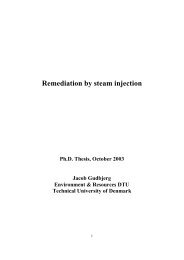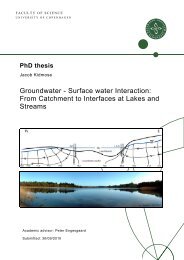Groundwater arsenic in the Red River delta, Vietnam ... - Fiva
Groundwater arsenic in the Red River delta, Vietnam ... - Fiva
Groundwater arsenic in the Red River delta, Vietnam ... - Fiva
You also want an ePaper? Increase the reach of your titles
YUMPU automatically turns print PDFs into web optimized ePapers that Google loves.
Jessen et al., manuscript to be submitted to Geochim. Cosmochim. Acta<br />
and N4 on day 9 has natural 18 O-values of -8.7‰ to -8.5‰, consistent with our<br />
previous study at <strong>the</strong> field site (Larsen et al., 2008). On day 34, <strong>the</strong> values of 18 O have<br />
<strong>in</strong>creased to -5.9‰ to -5.0‰, respectively, whereas on day 54 <strong>the</strong> 18 O-values have<br />
returned to -9.0‰ to -8.9‰. A sample taken from OB4, positioned upgradient and<br />
<strong>in</strong>land from <strong>the</strong> pump<strong>in</strong>g wells (Fig. 1b and 2), shows a similar 18 O-value of -9.0‰ on<br />
day 54. Contrast<strong>in</strong>g to <strong>the</strong>se values, <strong>the</strong> 18 O-value of <strong>the</strong> channel water decreases<br />
successively from -9.4‰ on day 9, to -10.9‰ on day 54, resembl<strong>in</strong>g <strong>the</strong> isotopic<br />
signature of <strong>the</strong> water <strong>in</strong> <strong>the</strong> <strong>Red</strong> <strong>River</strong> ma<strong>in</strong> channel (Larsen et al., 2008).<br />
3.2.2. Water chemistry<br />
The variation of <strong>the</strong> electrical conductivity (EC) and of major cations <strong>in</strong> groundwater<br />
and channel water dur<strong>in</strong>g <strong>the</strong> pump<strong>in</strong>g period is shown <strong>in</strong> Fig. 6 for <strong>the</strong> observation<br />
wells N1 and N4 and <strong>the</strong> channel water. Fig 6a shows an <strong>in</strong>itial EC of <strong>the</strong> groundwater<br />
of 765 μS/cm, while <strong>the</strong> EC of <strong>the</strong> channel water is at 180 μS/cm. On day 9 after <strong>the</strong><br />
start of pump<strong>in</strong>g <strong>the</strong> EC beg<strong>in</strong>s to decrease, <strong>in</strong>dicat<strong>in</strong>g <strong>the</strong> first appearance of water<br />
derived from <strong>the</strong> channel. The breakthrough curves for EC are shifted by ca. five days<br />
for <strong>the</strong> well closest to <strong>the</strong> channel (N1) and <strong>the</strong> well closest to <strong>the</strong> pump<strong>in</strong>g well (N4).<br />
On day 34, when <strong>the</strong> flow direction reverses, a m<strong>in</strong>imum EC of 340 μS/cm is observed<br />
<strong>in</strong> both N1 and N4. After day 34, <strong>the</strong> EC <strong>in</strong>creases aga<strong>in</strong>, but this time first <strong>in</strong> N4 and<br />
<strong>the</strong>n <strong>in</strong> N1. On day 54, <strong>the</strong> EC <strong>in</strong> <strong>the</strong> two observation wells has returned to <strong>the</strong> <strong>in</strong>itial<br />
(pre-pump<strong>in</strong>g) values. In <strong>the</strong> channel <strong>the</strong> EC <strong>in</strong>creases after day 34, and approaches that<br />
of <strong>the</strong> groundwater. This <strong>in</strong>dicates a discharge of groundwater to <strong>the</strong> channel subsequent<br />
to day 34, when <strong>the</strong> hydraulic head of <strong>the</strong> aquifer exceeds <strong>the</strong> channels stage (Fig. 5a).<br />
Dur<strong>in</strong>g <strong>the</strong> follow<strong>in</strong>g year, with no pump<strong>in</strong>g, <strong>the</strong> EC <strong>in</strong> N1 rema<strong>in</strong>ed at 930 ± 11 μS/cm,<br />
15





